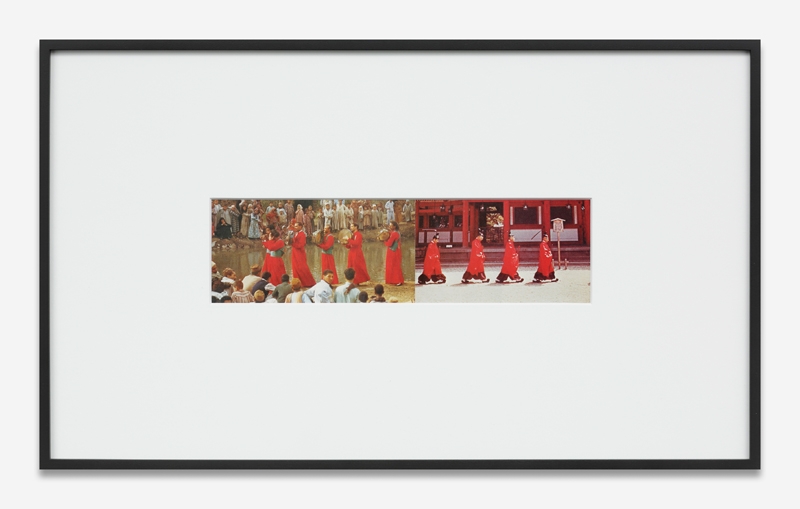Collage – placing something next to something else that has no causal relation to it – was a crucial modernist trope. The juncture is a clash of elements which only art conjoins, implying a contingency underlying all cultural juxtapositions. It is a rupture offering the possibility of conciliation, or reconciliation. It comprehends a modern culture in which relations between signs are multiplying exponentially and chaotically. Combining referentiality and serendipity, it is an ideal method for Pavel Büchler, who likes his allusions to have the air of experiments. In an interview, the Czech-born, UK-based artist alluded to W.H. Auden’s famous claim that ‘poetry makes nothing happen’ by saying ‘when I say that I make nothing happen, I mean that there are things in the world which already have their shape but seem like nothing, and you can activate them by merely noticing them. Suddenly they become “something” in quotes’. Auden’s exempting of art from having to justify itself pragmatically becomes Büchler’s revealing of the exceptionality of the familiar. What seems remarkable about this selection of his collages from the 1970s and 80s is how the likenesses they discover between diverse images have a flattening effect, subversive because it militates against the conventional dynamic of the method, which is to emphasise heterogeneity. Büchler shows the proliferating imagery of postmodern culture throwing up what Foucault called ‘similitude’ – the similar relating to the similar in the absence of any original object on which the copies are based.
Büchler has also said that ‘the poetic is by definition disinteresting’. If these collages have a disinterested, impersonal air, he offsets them with signs of personal testimony. A series of framed works are supplemented by his diaries, presented in vitrines, in which a modified photograph / illustration for the week converts a diary page filled out with quotidian trivia – ‘11.30 – Hygienist!’ – into an artwork. Often, a superimposed sliver of contemporary culture gently puns on an art reproduction. Yuri Geller bends a spoon with one hand, while his other, cropped out, is supplied by a figure in a Roman relief, flexing his bicep. The contemporary, like the subjective, is a rogue imposition on arthistorical precedent or on the generic, printed layout of a diary.
By association, Büchler’s self-revelation personalises the appropriative idiom of the wall-hung collages – appropriation being the use of things not your own. It never seems possible that Büchler took the photographs he is collaging. The framed works mostly feature two images the size of an over-thecounter print, in a passe-partout frame. They show gatherings of people working, playing sports, demonstrating, queuing. These are all ‘public’ images that confirm Walter Benjamin’s linking of photography with ‘the metropolitan masses’. The divide is usually a straight vertical, but Untitled (1987) stacks an Asian crowd over a Middle Eastern one, so the former, pictured from a greater distance, appears to recede behind the latter as a single human mass. Untitled (1987–8) has a musical troupe juxtaposed with four Samurai warriors. Hilariously, all are wearing long red gowns as though they were part of the same contingent, and the four Japanese, pictured from further away, were dwarfs.
The photographs do not register as glimpses of contingent reality, but as cultural signs short-circuited by their juxtaposition, and by its tendency to highlight the materiality of the prints, like a John Stezaker collage. But whereas Stezaker brings that materiality to signify the unknown particulars lurking behind photographic artifice, Büchler uses his collaged junctures to place the fact that these are photographic prints, and therefore artificial, ‘in quotes’. The contrasting function of the diaries is to suggest the hands-on dailiness of the process that has been applied to images which seem to have been condensed out of the cultural ether.
The collages in the second room mostly consist of art-historical reproductions, the crops more virtuosic, the conjunctions more facetious. Büchler’s savvy referencing makes these works seem the opposite of ‘disinteresting’. The discovery of homogeneity where we would expect rupture is less effective because the context is the narrower one of the already-mediated reality of art. Manet’s naked picnicker finds herself among Ingres’s odalisques. Picasso’s demoiselles muscle in on a social realist peasant. But dry humour occasionally redeems a display of cleverness. Two Antonins (105. Antonin Slavicek – 106. Antonin Hudecek) (1980–1) combines two bucolic nineteenth-century impressionist landscapes, one phasing into the other as though they were a single idyll. Each was painted in 1898 by one of the two Antonins of the title, Büchler disinterestedly crediting the accidents of history for his undeniable sleight of hand.
This article was first published int he January & February 2015 issue.
